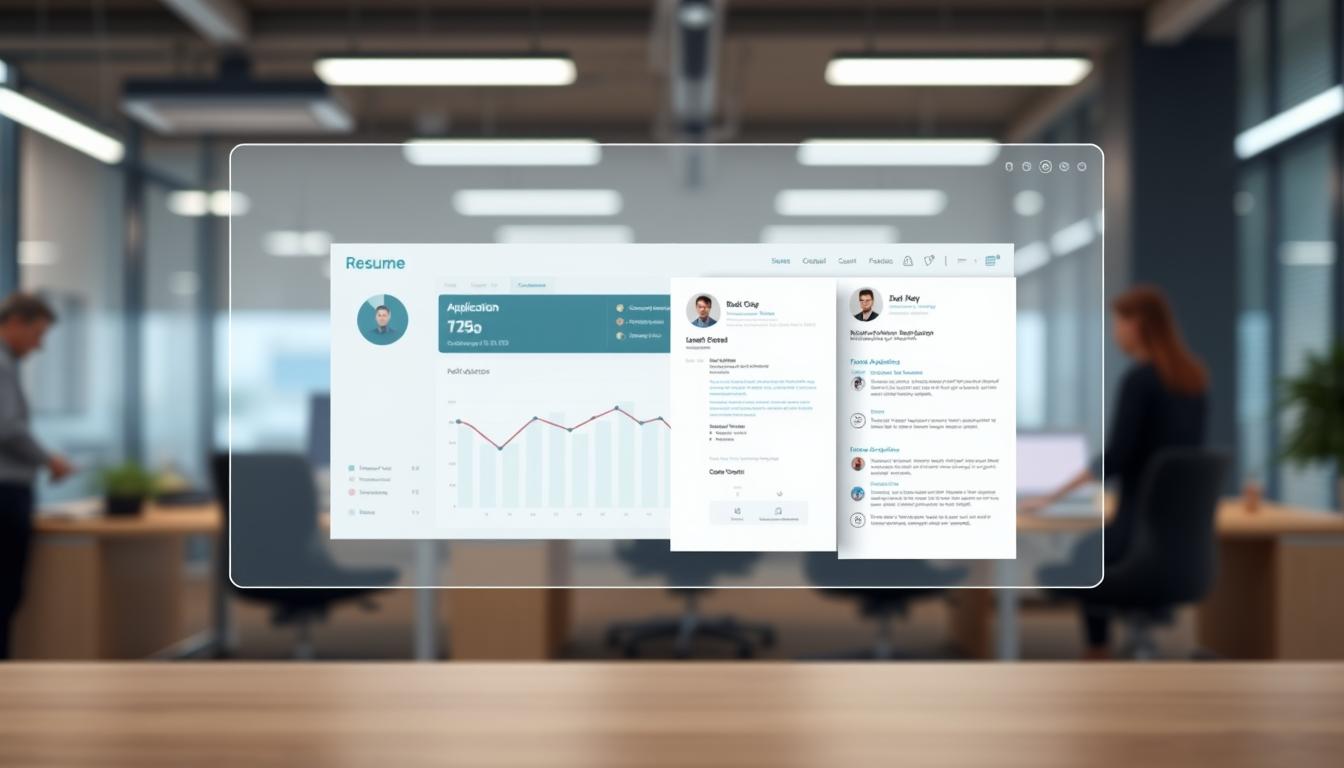Did you know that 75% of job seekers never get a response from employers? This shows why old ways of job hunting often don’t work in today’s tough market.
The 2025 job market needs a smart plan that uses professional job search tips and new tech. Success isn’t just about applying to lots of jobs. It’s about doing it smartly with the right tools and prep.
RoboApply changes how you look for jobs. It gives you tools that make every step easier. From AI to help with your resume to tracking your apps, you’ll stand out.
This guide will teach you to use old-school networking and new career advancement techniques to find your dream job. You’ll learn strategies that focus on what you can do. And how to keep going even when it’s tough.
Key Takeaways
- Strategic job searching beats mass applications every time
- Modern tools like RoboApply can automate and optimize your entire process
- Networking remains crucial even in the digital age
- Professional presentation through optimized resumes increases response rates
- Persistence and preparation are your strongest assets
- Technology integration gives you a competitive edge in 2025’s market
Understanding the Importance of a Cover Letter
A well-written cover letter can make your application stand out. Many focus only on their resumes. But, knowing the cover letter importance gives you an edge in today’s job market.
Your cover letter is your chance to introduce yourself to employers. It adds context that your resume can’t. It lets you show your personality, communication skills, and why you’re interested in the role and company.
Why a Cover Letter Matters
Hiring managers look at cover letters to see more than just your skills. They check if you can communicate well, which is key in most jobs.
Creating a application materials strategy means tailoring your cover letter for each job. No longer can you use the same cover letter for every job. By matching your skills and experiences to the job description, you show you’re really interested and detail-oriented.
Your cover letter is also a chance to address any concerns. If you’ve had gaps in employment or career changes, you can explain them positively. Being open can actually help you rather than hurt you.
Professional storytelling in your cover letter helps employers see you in the role. You can talk about your achievements and how they fit the job. This makes your application more memorable and interesting.
Common Misconceptions About Cover Letters
Many people believe wrong things about cover letters that can hurt their chances. Knowing these myths helps you avoid mistakes and make your application stronger.
The biggest myth is that cover letters are just resume summaries. Tips for creating cover letters show they should add to your resume, not repeat it. Your cover letter should tell the story behind your achievements and why you want the job.
Another myth is that employers don’t read cover letters. While some jobs don’t need them, a good cover letter shows you’re professional and thorough. Many hiring managers look for cover letters to see your communication skills and interest in the job.
| Cover Letter Benefits | Common Misconceptions | Reality Check |
|---|---|---|
| Demonstrates communication skills | Nobody reads cover letters | Many hiring managers use them for initial screening |
| Shows genuine interest in role | Cover letters are just resume summaries | They should tell your professional story uniquely |
| Addresses potential concerns | One cover letter fits all applications | Customization significantly improves success rates |
| Provides context for achievements | Cover letters are outdated | They remain valuable differentiation tools |
Some think cover letters are old-fashioned in today’s digital world. But, they’re still a great way to stand out. They show you’ve done your homework on the company and role.
The secret to a good application materials strategy is understanding your cover letter and resume are a team. When they work together, they tell a story that makes you the perfect fit for the job.
Key Elements of a Winning Cover Letter
Successful cover letters have common traits that make them powerful. They grab the attention of hiring managers and show your value. Understanding these winning cover letter components is key.
The best cover letters are personal, show relevant experiences, and have strong opening statements. These elements work together to tell your professional story.

Mastering these basics puts you ahead of generic applicants. Each part of your cover letter builds your case for the job.
Personalization for the Job
Personalization is more than just addressing the hiring manager by name. It shows you understand the company’s mission and challenges. This approach proves you’ve done your homework.
Start by exploring the company’s website, news, and social media. Look for culture, achievements, and projects. This research helps you tailor your application.
Include specific reasons why you want to work for this company. Mention initiatives, awards, or expansions that match your goals. This shows your genuine interest and sets you apart.
Tailoring your application materials to each job can make a big difference. Read job descriptions carefully and highlight your relevant skills and experiences.
RoboApply’s AI cover letter builder analyzes job descriptions and suggests personalized content. It helps you focus on key points while keeping your application authentic.
Highlighting Relevant Experiences
Your cover letter should highlight experiences that match the job. Focus on achievements that show you can do the job well. Use numbers to prove your impact.
Pick two to three key accomplishments to showcase. Explain the situation, your actions, and the results. This helps hiring managers see how you’ll fit in.
Here’s an example of presenting relevant experience:
“In my previous role as Marketing Coordinator, I increased social media engagement by 150% in six months. This led to 25% more qualified leads and a $50,000 revenue increase. My skills in analytics and content creation align with your Digital Marketing Specialist role.”
When changing careers or industries, focus on transferable skills and relevant projects. Explain how your background adds value, even if it’s different. This shows employers your unique qualifications.
| Experience Type | What to Highlight | Example Metrics | Connection to Role |
|---|---|---|---|
| Professional Achievement | Quantifiable results | Revenue increase, cost savings | Direct skill application |
| Project Leadership | Team management, outcomes | Team size, timeline, budget | Leadership requirements |
| Problem Solving | Challenge overcome | Efficiency gains, error reduction | Analytical skills needed |
| Technical Skills | Software, certifications | Proficiency level, training hours | Required technical competencies |
Strong Opening Statements
Your opening paragraph is crucial. It determines if hiring managers read on. A strong opening establishes your credibility and interest in the position. Avoid generic statements.
Start with a hook that connects your background to the role. This could be an achievement, a shared connection, or a reason why the company’s mission resonates with you. Your goal is to spark interest and encourage further reading.
Consider these effective opening statement frameworks:
- Achievement-based: Start with a specific accomplishment that relates to the job requirements
- Connection-based: Reference a mutual contact or shared experience with the company
- Mission-driven: Explain how the company’s values align with your professional goals
- Problem-solving: Identify a challenge the company faces and hint at your solution
Here’s an example of a strong opening statement:
“After successfully launching three mobile applications that collectively gained over 100,000 downloads, I’m excited to bring my user experience design expertise to TechCorp’s innovative product development team. Your recent expansion into healthcare technology aligns perfectly with my passion for creating solutions that improve people’s lives.”
RoboApply’s grammar checker and ATS optimizer help you craft polished opening statements. These tools ensure your cover letter stands out in competitive applicant pools. Learn more about effective cover letter writing.
Remember, your opening statement sets the tone for your entire letter. It should be confident, specific, and engaging. This balance makes a positive first impression and encourages hiring managers to learn more about you.
Tailoring Your Cover Letter for Each Job Application
Every job application needs a unique touch that speaks directly to the employer’s needs. Personalized cover letter guidance means avoiding generic letters. By creating targeted job applications, you show real interest and commitment.
Understanding the company and the role is key to customization. This turns your cover letter into a strong case for why you’re the best fit.
Researching the Company
Good company research techniques go beyond the “About Us” page. Look at their mission, recent news, and leadership team. This helps you grasp their current goals and challenges.
Social media offers insights into company culture and values. Check their LinkedIn page for updates and employee posts. Twitter and Facebook show their communication style and community involvement.
Industry publications and news articles give outside views on the company. Look for achievements, expansions, or challenges. This helps you show how you can help their success.
Employee reviews on Glassdoor offer insights into work environment and management. While skeptical, they help understand what the company values in its employees.
Using Job Descriptions Effectively
Job descriptions hint at what employers really want. Look for clues about the role’s needs and challenges. Notice the language and order of requirements.
Keywords in job postings reflect the company’s priorities. Mirror this terminology in your cover letter. This helps your application pass through systems and resonate with reviewers.
Look for common themes in job postings from the same company. These show their values and preferred styles. Show how your approach matches theirs.
Analyze both required and “nice to have” qualifications. The latter shows your ideal candidate profile. This helps you stand out from others who only meet the minimum.
This strategic approach to targeted job applications boosts your interview chances. It shows employers you’ve taken the time to understand their needs and challenges.
Structuring Your Cover Letter for Maximum Impact
Organizing your cover letter well can make it stand out. It turns into a story that shows off your skills. A good cover letter follows a three-part format that highlights your best qualities.
Having a clear structure helps your message flow smoothly. Each part has a role in showing why you’re the best fit. This way, you share all important info without confusing the reader.

Opening Paragraph Excellence
Your intro sets the tone for the whole letter. Start with the job title and where you saw the ad to show you’re detail-oriented. This helps hiring managers quickly see your application’s relevance.
Make a strong first impression by showing you know the company. Talk about something they’ve achieved recently or something in their mission that interests you. This shows you’re not sending out generic letters.
Also, mention your top skill in the intro. This gives hiring managers a reason to keep reading and builds excitement for what’s to come.
Body Content Strategy
Write one to two paragraphs that focus on your key skills. Each paragraph should have a single theme like technical skills or leadership experience. This keeps your message clear and avoids overwhelming the reader.
Use real examples and numbers to back up your claims. Instead of saying you “improved sales,” say you “increased quarterly sales by 23%.” Specifics make your achievements more believable and memorable.
Make sure your paragraphs flow smoothly. Connect your experiences to the job requirements clearly. This guide helps hiring managers see you in the role.
Address any concerns in your paragraphs. If you’re switching industries or have gaps, explain how your skills still apply. This shows you’re a strong candidate despite any challenges.
Closing With Confidence
Your conclusion should show your excitement for the job and company. Repeat your main qualification in different words to drive home why you’re a great fit. This repetition helps your strongest points stay with the hiring manager.
End with a call to action that shows you’re eager for the next step. Say you’d like an interview and plan to follow up soon. This shows you’re proactive and really interested in the job.
Finish with a professional closing like “Sincerely” or “Best regards,” and your full name. These tips help your cover letter look professional while showcasing your skills. Good structure is key to getting noticed.
Language and Tone: Finding the Right Balance
Your cover letter’s tone is key to connecting your skills with what the hiring manager wants. The right communication tone can make your application stand out. You should be confident but not too proud, enthusiastic but not too eager, and professional but not too formal.
To find this balance, know your audience and match their company culture. Look at the company’s website, social media, and job postings to see their preferred business writing style. A tech startup might like a casual tone, while a law firm needs a formal one.
Keeping It Professional yet Friendly
Being professional doesn’t mean being cold. You can be friendly and show your personality while still being professional. Start with a warm greeting and use confident language that shows your skills.
Show your excitement for the role without being too over the top. Instead of saying “I’m extremely excited,” say “I’m genuinely interested in contributing to your team’s success.” This shows you’re professional while being true to your motivation.
Match the company’s energy in your writing. If their job posting is lively and uses exclamation points, you can be enthusiastic too. But always be a bit more formal than casual.
RoboApply’s AI cover letter builder helps you find the right tone. It suggests phrases that are natural yet professional, based on industry standards.
Avoiding Jargon and Clichés
Phrases like “team player,” “results-driven,” and “thinking outside the box” are too common. They don’t tell hiring managers anything new about you.
Use specific examples to show your value. Instead of saying you’re detail-oriented, tell a story about a time when your attention to detail saved the day.
Industry jargon can confuse readers. While you should know your field, explain technical terms clearly. This shows you can communicate well with different people.
For more professional cover letter advice, use active voice and choose strong verbs. Let your achievements speak for themselves.
RoboApply’s grammar checker helps you avoid weak phrases and suggests better ones. Its ATS optimizer makes sure your language won’t get you rejected by screening systems, while still being appealing to humans.
- Replace weak phrases: “I believe I would be a good fit” becomes “My experience in X directly aligns with your need for Y”
- Use specific metrics: “Increased sales significantly” becomes “Boosted quarterly sales by 23%”
- Show personality: “I am writing to apply” becomes “Your recent expansion into sustainable technology caught my attention”
Your cover letter should sound like you wrote it, not like a template. Being authentic and professional creates a strong connection with hiring managers.
Common Mistakes to Avoid in Cover Letters
Knowing what not to do in your cover letter is as important as knowing what to include. Even experienced professionals can make mistakes that show they are careless or inexperienced. Best practices for cover letter development help you avoid these mistakes that can keep you from getting considered.
Most cover letter mistakes are common and can be prevented with careful preparation. These mistakes can quickly move you from the consideration pile to the rejection pile.
Overloading with Information
Many job seekers treat their cover letter like a second resume. This makes their documents too dense and overwhelming for hiring managers.
Hiring managers usually spend only 30-60 seconds reading cover letters. So, it’s crucial to be brief and focused. Your cover letter should highlight your three most important qualifications, not list every achievement.
To avoid information overload, follow these strategies:
- Select quality over quantity – Pick three specific examples that match the job requirements
- Use bullet points sparingly – Limit to 2-3 bullets if you use them
- Focus on recent achievements – Emphasize accomplishments from the last 3-5 years
- Eliminate redundant information – Don’t repeat details already in your resume
Your cover letter should complement, not duplicate, your resume. Application errors prevention begins with understanding this difference.
Failing to Follow Instructions
Small mistakes like wrong file formats or missing required elements can keep you from being considered. Companies often use specific application requirements as a first filter.
Be careful of these common mistakes:
- File format errors – Submitting the wrong file type
- Length requirements – Going over the word or page limit
- Submission method mistakes – Using the wrong email or application portal
- Missing required information – Forgetting to include salary requirements or availability dates
If you don’t hear back, send a polite follow-up to show you’re still interested. But be careful with AI tools for help, as they can introduce errors. Always check your cover letter carefully before sending it.
For more on avoiding these and other mistakes, see our detailed guide on common cover letter errors. This approach to application errors prevention makes your cover letter a strong asset, showing the professionalism employers value.
Complementing Your Resume with a Strong Cover Letter
Understanding how your cover letter boosts your resume’s power is key. These documents should work together like a team. Your resume lists your achievements, while your cover letter explains why they matter.
Your application package is a complete story. Your resume lists your achievements, but your cover letter tells why they’re important. This teamwork makes a strong case for you that neither document can make alone.

How a Cover Letter Enhances Your Resume
Your cover letter adds depth to your resume. It explains how you got those achievements. For example, it can detail how you boosted sales by 25% through new customer strategies.
Cover letters address concerns your resume might raise. They turn career gaps or industry changes into chances to show growth. You can talk about why you’re excited to change fields or how your varied experience brings new perspectives.
Use your cover letter to highlight specific achievements. Here’s a good way to do it:
“While my resume mentions managing a team of 15, it doesn’t show how I turned a struggling department into the top performer. I did this through mentorship and process improvements that cut project time by 40%.”
AI tools like ChatGPT can refine your resume and cover letter. They help match your experience to job needs. Always check for errors after using these tools.
Good cover letter examples show how to link resume points to real impact. Instead of just listing your achievements, explain how they lead to success in the job you want.
Coordinating Themes between Documents
Effective resume coordination means matching messaging and tone. Your personal brand should shine through both documents. If your resume highlights leadership, your cover letter should give examples.
Use the same language and keywords in both documents. This creates a strong narrative that shows your value. When your documents speak the same language, they make a stronger impression than if they don’t.
Consider this coordination strategy table:
| Resume Element | Cover Letter Enhancement | Coordination Strategy | Impact Level |
|---|---|---|---|
| Job Title | Career progression story | Show growth trajectory | High |
| Skills List | Specific skill applications | Provide concrete examples | Very High |
| Achievement Metrics | Context and methodology | Explain the “how” behind numbers | Maximum |
| Education | Relevant coursework connection | Link learning to job requirements | Medium |
Your documents should complement each other, not repeat the same information. Use your cover letter to expand on resume highlights that match the job. This way, you avoid repetition.
Creating a matching cover letter and resume requires attention to visual consistency and messaging. Both documents should reflect your professional brand through consistent formatting and tone.
RoboApply’s AI resume and cover letter builder ensures consistency. It analyzes your content and suggests improvements. The platform’s ATS optimizer helps your documents pass applicant tracking systems while remaining appealing to humans.
Remember that hiring managers often review these documents together. When your application materials work together, they create a professional package. This approach shows you’re detail-oriented and strategic.
Strong application materials synergy makes you stand out as a thoughtful candidate. Your coordinated effort shows professionalism and boosts your chances of getting interviews.
Leveraging Online Resources and Tools
Smart digital tools can make your cover letter stand out. They help you find jobs faster and better. Digital job search tools give you an edge over others.
AI is changing job searching in big ways. It helps with resumes, job matches, and interview prep. Using AI tools can make your job search more efficient and boost your chances of getting interviews.

Professional Templates That Work
Quality templates are key for professional cover letters. RoboApply’s AI-powered cover letter builder offers templates for different industries. They fit your experience and the job you want.
These templates work well with ATS systems and look good to humans. You can change colors, fonts, and layouts to fit your style. This saves time and makes your cover letter look great.
Smart templates also help with organizing your content. They show you where to put your best skills and how to tell your story. This makes your cover letters effective every time.
Comprehensive Writing Resources
Good writing guides improve your skills. Leveraging AI for crafting resumes and cover letters is key for job seekers today.
RoboApply’s platform offers templates, writing help, and grammar checks. It analyzes job descriptions and suggests content that meets employer needs. This ensures your cover letters meet specific requirements.
The platform’s features go beyond spell-checking. Advanced grammar analysis finds weak phrases and offers better options. The ATS optimizer uses keywords that hiring systems value.
These online application resources make your application materials better. They combine templates, writing tips, and AI help. This streamlines your process and improves your work. You can focus on telling your story without worrying about formatting.
Modern job searching needs modern tools. Using these digital tools shows you’re tech-savvy and up-to-date with industry standards.
Seeking Feedback on Your Cover Letter
Getting fresh eyes on your cover letter can reveal areas for improvement you might overlook. Reviewing your own work too much can blind you to its weaknesses. Professional feedback and peer reviews offer the outside view needed to make your application stand out.
Building a network of trusted reviewers takes time but is worth it for your career. Look for people who know your industry well and can give honest, helpful feedback. These connections will help you in future job searches and career growth.
Peer Reviews
Your professional network is a treasure trove of knowledge for cover letter improvement. Reach out to former colleagues, mentors, and job seekers in your field. They can offer insights based on their own experiences.
When asking for feedback, share the job description and your cover letter. This helps reviewers understand your goals. Ask specific questions like “Does my opening paragraph grab attention?” or “Do I clearly show how my experience fits their needs?”
Joining groups like Never Search Alone can help. These communities support each other’s job searches. You can also meet potential reviewers at local industry events.
Peer review works best when it’s a two-way street. Offer to review others’ materials in return for their time and expertise. This builds strong professional relationships that last beyond your current job search.
Professional Writing Services
For senior roles or big career changes, expert help might be worth it. Professional writing services know industry standards and what hiring managers want. They catch issues that even friends might miss.
When looking for services, find ones that get your industry and career level. RoboApply’s AI tools offer detailed feedback and suggestions. They help you catch errors and improve your cover letter.
The best strategy combines tech and human insight. Use RoboApply to find basic errors, then get human feedback for strategy and industry-specific advice. This ensures your cover letter shows your best professional side.
Professional services vary in quality and focus. Some just check grammar, while others offer strategic advice. Choose services that match your needs and budget. The best ones will ask about your background, goals, and target roles.
| Feedback Source | Best For | Typical Cost | Turnaround Time |
|---|---|---|---|
| Peer Reviews | Industry insights and general readability | Free (reciprocal) | 3-7 days |
| RoboApply AI Tools | Grammar, structure, and optimization | Subscription-based | Instant |
| Professional Writers | Strategic positioning and expert polish | $75-300 | 1-3 days |
| Career Coaches | Comprehensive application strategy | $100-500 | 1-2 weeks |
These tips for creating cover letters through feedback are more valuable with a systematic approach. Start with automated tools for basics, then peer reviews for industry insights. For high-stakes applications, consider professional services. This layered approach maximizes your investment and covers all potential areas for improvement.
Final Tips for Crafting a Standout Cover Letter
Your cover letter journey ends with two key steps. These steps help your effective cover letter writing make a strong impression on hiring managers.
The Importance of Proofreading
Even the best content can be hurt by small mistakes. Typos and grammar errors show you’re not detail-oriented. This is crucial in most jobs.
Read your cover letter out loud to find awkward phrases or missing words. Make sure formatting, font, and spacing are consistent. Double-check company names, job titles, and contact info for accuracy.
Take a break before proofreading to see your letter with fresh eyes. Printing it out can help spot errors more easily than on a screen.
When to Follow Up with Your Application
Professional communication goes beyond just applying. Send a thank-you email within 24 hours of any interview. Mention something specific from your talk to show you’re really interested.
Be patient but keep following up. If you don’t hear back in a week or two, send a polite email. Keep it short and show you’re still excited about the job without being too eager.
FAQ
Are cover letters still necessary in 2025’s job market?
Yes, cover letters are still key in the job hunt. They show you’re professional and stand out. They add context to your resume and let you show you really want the job.
They help hiring managers see if you fit the company’s culture and if you’re motivated. This makes them a must-have for getting noticed.
How long should my cover letter be?
Keep your cover letter short and sweet, ideally one page. Hiring managers only glance at them for 30-60 seconds. So, focus on being impactful and concise.
Choose your best qualifications and present them clearly. Use a strong intro, 1-2 paragraphs about your achievements, and a confident conclusion.
Should I customize my cover letter for each job application?
Absolutely. Generic cover letters get tossed. Tailored ones show you’ve put in effort and really care about the job.
Do your homework on the company. Analyze their website and recent news. Use their language to show how you fit the role.
What’s the biggest mistake people make in cover letters?
The biggest mistake is trying to include everything. This makes your message weak. Focus on what really matters for the job.
Also, don’t ignore application instructions. Wrong file formats or missing info can get you rejected right away.
How do I write a strong opening statement for my cover letter?
Start with something that grabs attention. Mention the job and show you know the company. Use a hook that makes the reader want to keep reading.
Avoid generic starts. Instead, talk about the company’s achievements or challenges. This shows you’ve done your homework.
What tone should I use in my cover letter?
Aim for a professional yet friendly tone. Show your enthusiasm and personality but stay professional. Match the company’s style based on their website and job posts.
Use confident language that shows your skills without coming off as arrogant. Avoid clichés and use specific examples to prove your worth.
How should my cover letter complement my resume?
Your cover letter should add to your resume, not repeat it. Use it to explain your career choices and highlight your achievements. It should tell a story that reinforces your value.
Keep your branding consistent across both documents. This makes your application stronger and more cohesive.
Can AI tools help me write better cover letters?
Yes, AI tools like RoboApply’s cover letter builder can help a lot. They analyze job descriptions and suggest personalized content. They also ensure your letter looks good and works with ATS systems.
But remember, AI can’t replace your personal touch. Add your own experiences and insights to make your letter truly yours.
Should I get feedback on my cover letter before submitting?
Getting feedback is a great idea. Ask people you trust for their honest opinion. Fresh eyes can spot things you might miss.
Use AI tools for grammar checks and formatting. But also get human feedback to make sure your letter is perfect.
What are the essential elements every cover letter needs?
Every good cover letter has three key parts: personalization, relevant experiences, and a strong opening. These should be organized clearly and professionally.
Make sure your tone fits the company culture. This will help you stand out and show you’re a good fit.
How do I avoid common cover letter clichés?
Use fresh language and specific examples instead of clichés. Instead of saying you’re a “team player,” describe a time when you worked well with others.
Be specific about your achievements. Use industry terms but keep your language clear and authentic.
When should I follow up after submitting my cover letter and resume?
Wait about one to two weeks after applying before following up. If the job post says to wait longer, do that.
Send a polite email asking about your application status. Don’t be pushy. If you don’t get a response, wait a bit longer before asking again.


















